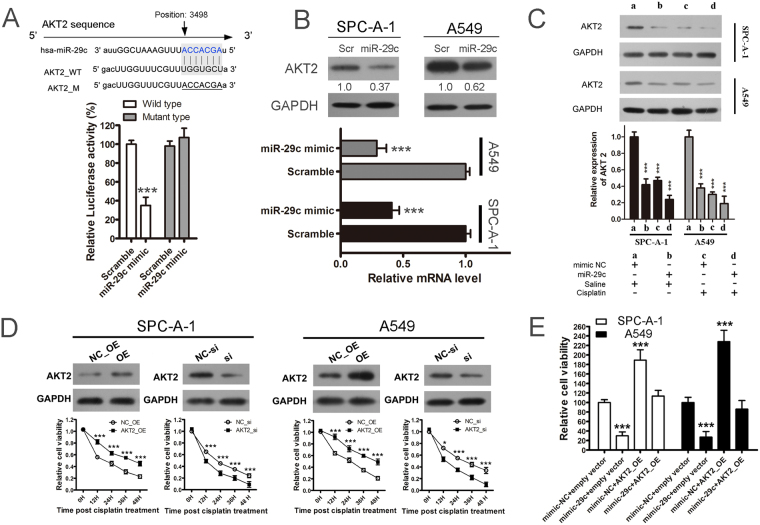Figure 4.
MiR-29c enhances cisplatin sensitivity of lung cancer cells by repressing AKT2 expression. (A) AKT2 is a potential target gene of miR-29c. Schematic representation of AKT2 3′-UTRs showing putative miR-29c target site (up). Luciferase activity assay with wild-type AKT2 3′-UTRs constructs and mutated luciferase constructs (down). (B) Cisplatin downregulated the expression of AKT2 at both the protein and mRNA levels in SPC-A-1 and A549 cell. Scr/Scramble: microRNA mimic negative control. MiR-29c: miR-29c mimic. (C) Both cisplatin treatment and miR-29c overexpression reduce the expression of AKT2. We used 10 µg/ml of cisplatin to treat SPC-A-1 and A549 cells for 12 hours and the AKT2 protein level and RNA level was detected by western blot or real-time PCR respectively. Mimic NC: microRNA mimic negative control. (D) Overexpression of AKT2 led to higher cell viability while knocking down of AKT2 led to lower cell viability post cisplatin treatment. AKT2 was overexpressed or knocked down by pcDNA3.1 vector or siRNAs transfection. NC-OE: pcDNA3.1 empty vector used for overexpression negative control. OE: AKT2 overexpression. NC-si: siRNA negative control. Si: siRNA used for AKT2 knockdown. (E) Gene rescue experiments demonstrated that miR-29c could enhance the cisplatin sensitivity by negatively regulating AKT2. Mimic-NC: microRNA mimic negative control. AKT_OE: AKT2 gene overexpression by pcDNA3.1 system.

